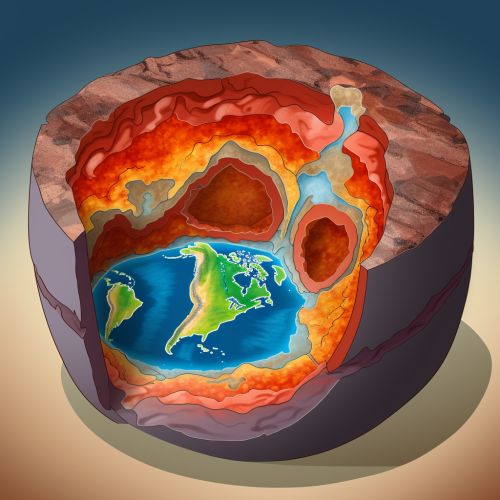Earth's Mantle
Introduction
The Mantle is the layer of the Earth located between the crust and the core. It is the largest layer of the Earth, accounting for about 84% of the planet's volume. The mantle is primarily composed of silicate rocks rich in iron and magnesium, and its structure is divided into two main parts: the upper mantle and the lower mantle.


Composition
The Earth's mantle is composed of a variety of minerals, primarily silicate minerals. These include olivine, pyroxene, and garnet, which are all rich in iron and magnesium. The mantle also contains smaller amounts of other minerals, such as spinel and perovskite. These minerals are formed under the high temperatures and pressures found within the mantle.
Structure
The Earth's mantle is divided into two main parts: the upper mantle and the lower mantle. The upper mantle extends from the base of the crust to a depth of about 410 kilometers. The lower mantle extends from the base of the upper mantle to the core-mantle boundary, at a depth of about 2,890 kilometers.
Upper Mantle
The upper mantle is further divided into three layers: the lithosphere, the asthenosphere, and the transition zone. The lithosphere is the rigid outermost layer of the Earth, encompassing the crust and the uppermost part of the mantle. The asthenosphere is the layer of the mantle located beneath the lithosphere, characterized by its ability to flow and deform. The transition zone, located between the asthenosphere and the lower mantle, is marked by a significant increase in seismic velocities.
Lower Mantle
The lower mantle extends from the base of the transition zone to the core-mantle boundary. It is characterized by high pressures and temperatures, and its composition is believed to be more iron-rich than the upper mantle. The lower mantle is also thought to contain a region known as the D'' layer, which is located just above the core-mantle boundary and exhibits complex seismic characteristics.
Dynamics
The Earth's mantle plays a crucial role in the dynamic processes that shape the Earth's surface. These include plate tectonics, volcanism, and seismic activity.
Plate Tectonics
The movement of the Earth's lithospheric plates is driven by the flow of the mantle beneath them, a process known as mantle convection. This process is responsible for the creation of new crust at mid-ocean ridges, the subduction of old crust into the mantle at trenches, and the movement of continents.
Volcanism
Volcanism is the eruption of molten rock, or magma, from the Earth's mantle to the surface. This occurs at locations where the mantle is melting, such as at mid-ocean ridges and in certain parts of the mantle above subducting plates.
Seismic Activity
Seismic activity, or earthquakes, occur when stress within the Earth's lithosphere is released. The mantle plays a key role in this process, as the movement of the mantle through convection can cause stress to build up within the lithosphere.
Study and Exploration
The study and exploration of the Earth's mantle is a key area of research in the field of earth science. This includes the use of seismic waves to study the mantle's structure, the study of rocks brought to the surface from the mantle, and the use of computer models to simulate mantle processes.
